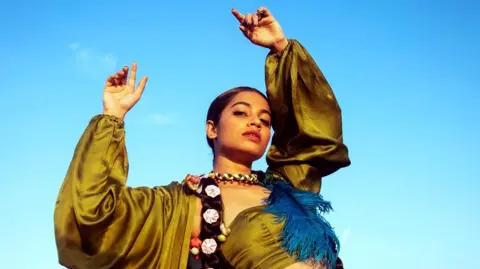
 Supriya Songs / Courtesy Prime Video
Supriya Songs / Courtesy Prime VideoA woman dances in the spotlight, the shimmering tassels on her dress quivering and swaying along with her movements.
But it's her arms that catch the light. They wave, spin and whip through the air at breathtaking speed, almost like the blades of a fan.
These are the opening images for a recently released web series on Amazon Prime Video called Waack Girls, a drama centered around six women who learn a new dance form to become the first all-female dance crew in their town.
Not much is known about the dance and so women have to fight hard – against society and their families – to be taken seriously. But ultimately waacking is the gift that keeps on giving.
Directed by Soni Taraporevala, the series is released at a time when many Indian cities – big and small – are seeing a renewed interest in waking.
“I was fascinated by the style of dance and the importance it places on self-expression,” Taraporevala says of why she made the series.
Workshops and underground dance parties – events where dancers compete with their moves – are springing up in many cities and world dance legends visit the country to teach dance.
Recently, Archie Burnett, who was a club dancer in New York in the 1970s and 1980s and a respected figure in the waking community, visited India for a dance recital.
 Soni Taraporevala
Soni TaraporevalaThe dancers hope that the web series will give waacking more visibility in the country and show people that there is more to dance than classical, hip-hop and Bollywood forms.
Waacking has a history filled with the LGBTQ+ liberation movement and the freedom powered by disco music.
The dance style emerged in gay clubs in Los Angeles in the 1970s, when there was a lot of stigma surrounding homosexuality. Gay men used waacking to express themselves on the dance floor and respond to the hate and discrimination they experienced.
Consequently, the dance style developed fast, sharp, powerful movements – much like the way comic book action heroes beat up villains, accompanied by sound effects such as “ka-paw” and “bam”.
“The word waacking comes from the phonetic word ‘whack,’ and it is reminiscent of (the effects) in comic books,” says Tejasvi Patel, a Mumbai-based dancer who has been dancing for over a decade.
The dance style is also inspired by Hollywood drama and its leading ladies. Dramatic poses, rapid footwork and striking arm movements are hallmarks of waacking, but dancers continue to add new movements to the repertoire of steps, as the celebration of individuality and self-expression is at the heart of the form.
 Tejasvi Patel
Tejasvi PatelBecause of its underlying ethos, waacking continues to be a tool of empowerment and self-expression for the LGBTQ+ community in India.
“In fact, many people explore their gender identity through dance style because it allows space for reflection and expression,” says Ayushi Amrut, who has been singing since 2012 and is a frequent host of Red Bull's Your House Is Waack show — a rave party show. For dancers all over the country.
“Another important factor is that the waking community always strives to be a safe place, so that people feel comfortable expressing themselves,” she adds.
When Amrut was introduced to waking by her dance teacher, the style was almost unknown in India. Her teacher encouraged her to watch videos and connect with dancers abroad to learn more about the style.
“We (a bunch of Indian dancers who started dancing over a decade ago) learned dance the hard way; by doing our own research, learning about the history of dance and connecting with dancers in countries where dance was popular,” says Amrut.
Patel remembers learning waacking the same way. But things are markedly different today. In the past five years or so, the dance style has gained popularity, as more young people flock to classes to learn it.
Patel, who teaches dance, says she encourages her students to adhere to the spirit of the style — unabashed self-expression.
She adds that when it comes to music, India is yet to find the right soundscape for this style. Songs from disco queen Donna Summer and American pop legend Diana Ross remain popular, as do songs from the 1983 film Staying Alive.
Bollywood had its own disco era too, with songs like Koi Yahan Nache Nache and Aap Jaisa Koi becoming chart-toppers in the 1980s, but they don't often find space in today's jams.
For Waack Girls, Taraporevala brought in independent artists to create an album of original soundtracks, which Patel says created a new and promising soundscape for waackers in India.
“I think it's time for people to fully embrace themselves, and waacking is the perfect platform to showcase what you find,” says Patel.









